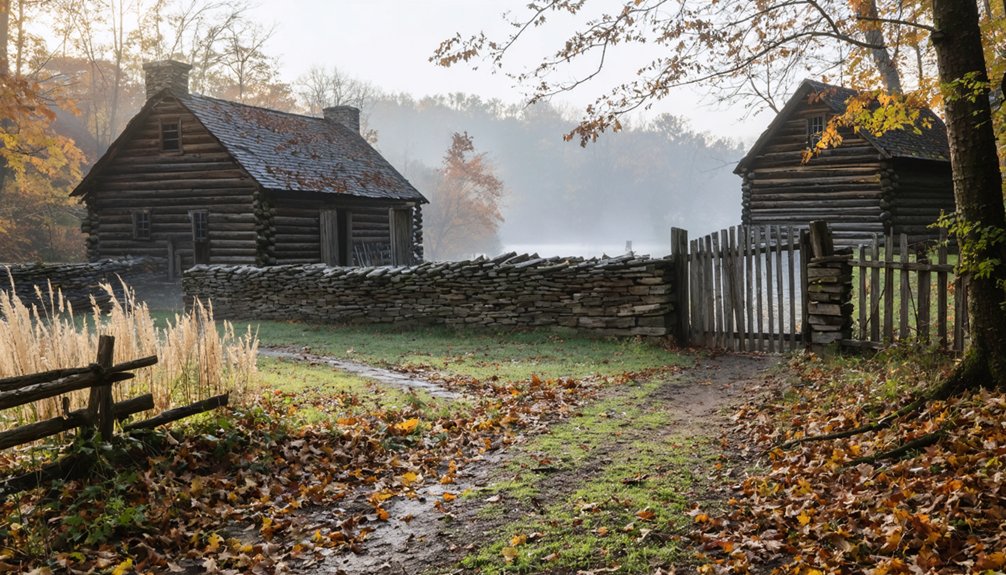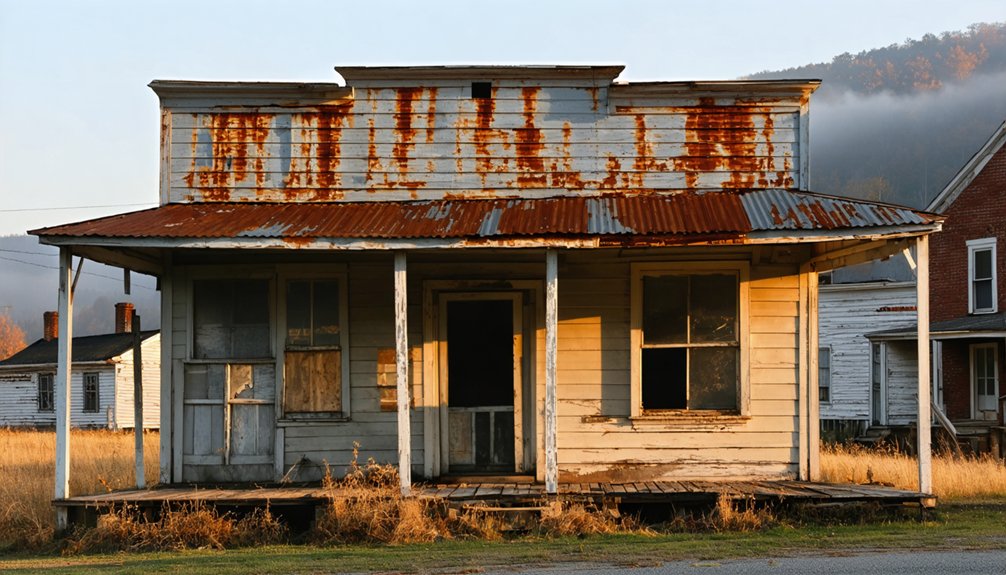You’ll find Fort Boonesborough’s transformation from a bustling Revolutionary War stronghold to Kentucky’s most significant ghost town uniquely compelling. Founded in 1775 by Daniel Boone, this frontier settlement once boasted 26 log cabins and four blockhouses, serving as the Transylvania Colony’s capital. Though the fort’s strategic importance waned after westward expansion, archaeological excavations continue to uncover colonial artifacts and aboriginal gun flints. The site’s evolution into a modern state park preserves centuries of American frontier heritage.
Key Takeaways
- Fort Boonesborough transitioned from a bustling frontier settlement to abandonment as westward expansion pushed beyond Kentucky’s borders.
- By 1820, the once-thriving settlement had largely declined, with most original settlers moving to more developed areas.
- The fort’s military and strategic importance diminished after the American Revolution, leading to its gradual abandonment.
- Archaeological excavations reveal layers of history from the fort’s active period through its decline into a ghost town.
- The site remained largely abandoned until 1963, when it was established as Fort Boonesborough State Park to preserve its history.
The Rise and Fall of a Revolutionary War Stronghold
When Daniel Boone and his men established Fort Boonesborough in April 1775, they laid the foundation for what would become one of Kentucky’s most strategically important Revolutionary War strongholds.
You’ll find that within months, the settlement grew to include 26 log cabins and four blockhouses, demonstrating remarkable community resilience in the frontier wilderness.
The first representative government in Kentucky was established at the fort in May 1775, marking a pivotal moment in the region’s history. As the capital of the Transylvania Colony, the fort’s military strategies proved essential during the 1778 siege when Shawnee warriors launched a determined assault. The garrison’s successful defense against Chief Blackfish’s forces secured America’s foothold in Kentucky. The defenders maintained their positions despite the Shawnee’s attempts to tunnel under walls during the siege.
However, the fort’s significance waned after the war, and despite its role in westward expansion and the tobacco trade, it gradually fell into abandonment by the early 19th century.
Daily Life Behind Fort Walls
Life behind Fort Boonesborough’s walls centered on a complex network of daily routines and specialized skills that sustained the settlement’s 26 log cabins. You’d find settlers engaged in essential crafts like soap making, candle making, and woodworking, while cooking methods utilized iron pots and frontier preservation techniques.
The community dynamics revolved around close-knit families sharing one-story dwellings and working together at specialized trade areas. Inside the fort’s palisades, you’d witness women practicing household crafts, children learning 18th-century skills, and artisans treating hides and working with horn. Live interpreters now demonstrate these activities in the fort’s replica log cabins.
The settlement’s survival depended on coordinated efforts in food preparation, hunting, and gathering, supplemented by trade. During holidays, you’d experience frontier traditions with candlelight decorations and period music, reinforcing the bonds of this pioneering community. Today’s resident artisans continue this legacy by providing authentic craft demonstrations for visitors.
Archaeological Treasures and Pioneer Stories
Through advanced geophysical surveys and systematic excavations, Fort Boonesborough‘s archaeological investigations have revealed a treasure trove of colonial-era artifacts and structural remains.
You’ll find evidence of siege survival in recovered aboriginal gun flints and structural features, including a dry-laid stone foundation that dates to the late 18th century.
Archaeological teams are actively searching for the collapsed tunnel reportedly dug by Native Americans during the dramatic 1778 siege.
The artifact significance extends beyond the colonial period, with diagnostics from a Fort Ancient village dating to 1400 AD.
You can participate in ongoing excavations as a volunteer, contributing to the site’s preservation while uncovering pieces of pioneer history.
The fort’s designation as a National Historic Landmark underscores its essential role in America’s westward expansion.
The project receives support from the American Battlefields Protection Program to help preserve this significant cultural site.
Ground penetrating radar technology helps archaeologists identify potential subsurface features before beginning excavations.
Daniel Boone’s Legacy in Kentucky
Beyond the archaeological treasures that document Fort Boonesborough‘s physical history lies the enduring legacy of its most famous founder.
Daniel Boone’s leadership transformed Kentucky from wilderness to settlement, establishing vital foundations through his strategic development of Fort Boonesborough in 1775. You’ll find his influence in the Wilderness Road he blazed, which became the primary route for hundreds of thousands of settlers entering Kentucky. Over 200,000 settlers traversed his marked routes into Kentucky by the century’s end.
Through sheer determination and vision, Boone carved the path that would transform Kentucky’s untamed frontier into a gateway for American settlement.
As captain in the Virginia Militia, Boone’s military prowess proved essential in defending the fort against Native American raids while facilitating diplomatic negotiations with Cherokee leaders. In 1778, he orchestrated the successful defense of the fort during the Siege of Boonesborough, repelling the final Shawnee assault.
His wilderness exploration and surveying skills opened vast territories for settlement, while his collaborative approach to fort development created a model for frontier communities.
Today, his achievements symbolize the American spirit of exploration, preserved through historical sites across Kentucky.
From Frontier Settlement to Modern State Park
Despite its promising beginnings as Kentucky’s first fortified settlement in 1775, Fort Boonesborough‘s shift from frontier outpost to ghost town unfolded gradually after the American Revolution.
As frontier challenges eased and settlement expansion pushed westward, the fort’s strategic importance diminished. Under the leadership of Daniel Morgan Boone, the fort’s original commander and his son successfully defended the settlement during numerous conflicts. By 1820, you would’ve found only a shadow of the once-vital garrison that had weathered the Great Siege of 1778 and served as Kentucky’s first seat of representative government. The fort’s first legislative assembly known as the Transylvania Convention marked a pivotal moment in western frontier governance.
While the original settlement faded into ruins, its historical significance endured. You can now explore Fort Boonesborough State Park, established in 1963, where a reconstructed fort brings the colonial frontier experience to life.
The site’s transformation from abandoned settlement to preserved historical landmark guarantees that you’ll understand the essential role it played in Kentucky’s early development.
Frequently Asked Questions
What Happened to the Original Settlers After the Fort Was Abandoned?
You’ll find settler migration patterns led many to Kentucky frontier towns like Harrodsburg, while others followed Boone’s Wilderness Road westward. Fort abandonment consequences drove families toward emerging economic opportunities elsewhere.
Were There Any Documented Paranormal Activities at Fort Boonesborough?
You won’t find officially documented paranormal sightings at Fort Boonesborough, though its historical significance and Revolutionary War-era events could provide compelling groundwork for potential ghost stories and unexplained phenomena.
How Many Women and Children Lived at the Fort?
You’ll find that exact settler demographics and family roles aren’t well documented, though historical records confirm women and children were present among the fort’s pioneering population throughout its occupation.
Did Any Notable Marriages or Births Occur Within the Fort?
You’ll be intrigued to know that notable unions occurred, including Samuel Henderson’s marriage to Elizabeth Callaway in 1776. Historical births followed, with Fanny Henderson becoming Kentucky’s first child born to Kentucky-married parents.
What Native Tribes Specifically Attacked or Traded With Fort Boonesborough?
You’ll find the Shawnee were the primary attackers at Fort Boonesborough, leading numerous raids and sieges. While Cherokee initially traded land rights, ongoing Shawnee attacks dominated the fort’s Native American relations.
References
- https://archaeology.ky.gov/Find-a-Site/Pages/Fort-Boonesborough.aspx
- https://www.worldatlas.com/historic-sites/5-must-see-historic-forts-in-kentucky.html
- https://en.wikipedia.org/wiki/Boonesborough
- https://www.fortboonesboroughstatepark.com
- https://kentuckyhistorictravels.com/2023/06/21/daniel-boone-the-man-the-myth-the-legend-part-one/
- https://www.visitlex.com/listing/fort-boonesborough-state-park/5976/
- https://www.fortboonesboroughlivinghistory.org
- https://www.dar.org/national-society/historic-sites-and-properties/fort-boonesborough
- https://www.battlefields.org/learn/revolutionary-war/battles/fort-boonesborough
- https://en.wikipedia.org/wiki/Fort_Boonesborough_State_Park



